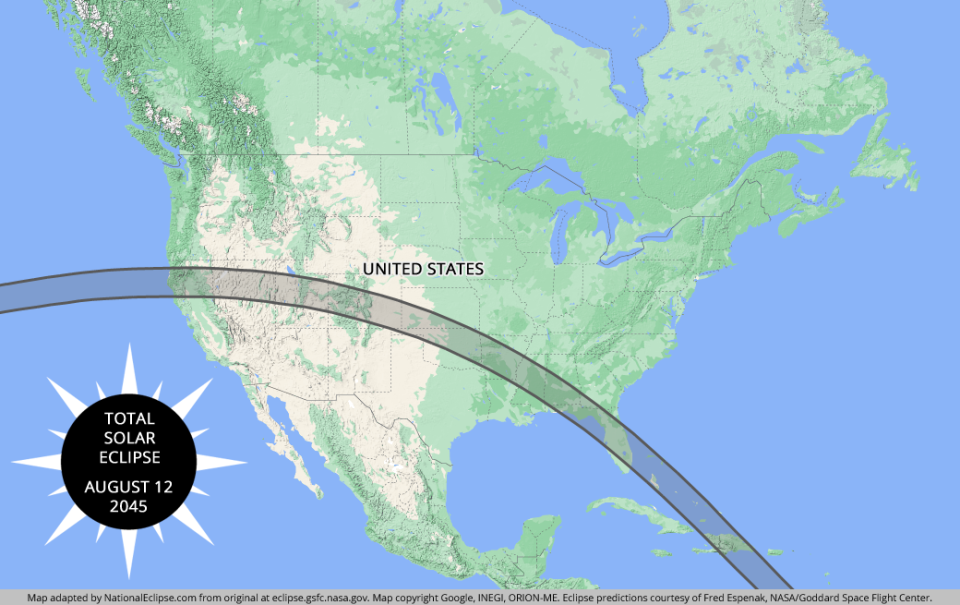Search by ZIP code for viewing guide of April's solar eclipse across Florida, US
Excitement is building for the 2024 solar eclipse.
While Florida won't be in the path of totality, residents will be able to see a partial eclipse. Those in the northern parts of the state will see the moon block more of the sun than those farther south.
It's important to emphasize: Do not look directly at the sun, even during an eclipse. You can seriously damage your eyes. There's still time to get a pair of solar glasses or make a pinhole projector.
Want to have some fun while viewing the eclipse? Wear red or green during the eclipse for a fun science lesson.
See when the eclipse will occur and what it'll look like from Florida.
When is the solar eclipse?
The solar eclipse will take place April 8.
What will the solar eclipse look like in Florida?
Can't see our graphics? Click here to reload the page.
Countdown clock to 2024 solar eclipse
Path of 2024 total solar eclipse
The path of totality for April's solar eclipse stretches from northern Mexico to southeastern Canada before moving over the Atlantic Ocean.
In the United States, April's total solar eclipse will cross 13 states.
Texas, Oklahoma, Arkansas, Missouri, Illinois, Kentucky, Indiana, Ohio, Pennsylvania, New York, Vermont, New Hampshire and Maine, plus parts of Tennessee and Michigan, are all in the 115-mile-wide path of totality.
To see the exact path of totality, check out an interactive map created by French eclipse expert Xavier Jubier.
How much of the solar eclipse will be visible in Florida?
Florida is not in the path of totality for April's solar eclipse. That means the moon won't totally block the sun.
Depending on where you are in the Sunshine State, the moon will block anywhere from 54 percent to 82 percent of the sun. Residents in the northwest corner of the state will see more of the eclipse.
➤ See exact times to go outside to see the eclipse across Florida
What's the best place in Florida to see the Great North American Eclipse?
Pineville, in the northwestern tip of Florida's Panhandle, is the city in Florida where the greatest percentage of the sun will be covered during the eclipse, according to Eclipse2024.
At the midpoint of the eclipse, Pineville viewers will see 82.4 percent of the sun covered at 1:55 .m. CDT, closely followed by Bratt with 82.3 percent of the sun blocked by the moon.
Can you damage your eyes if you look at the sun during an eclipse?
Yes. The only time you can look directly at the sun is when the moon totally blocks it, which will not happen anywhere in Florida.
Looking directly at the sun can cause permanent damage to your eyes, including blindness.
To look at the sun to see the eclipse, you'll need solar eclipse glasses or some sort of projector.
Warby Parker is offering free eclipse glasses at any of its locations starting April 1. Some libraries have free solar glasses available but call first to make sure some are still available.
Florida will be in path of totality for 2045 solar eclipse

While Florida will see only a partial eclipse on April 8, mark your calendars for another eclipse with a great view.
On Aug. 12, 2045, a total solar eclipse will be visible over almost all of Florida, according to NationalEclipse.com.
2045 solar eclipse and Florida: Mark your calendar! Florida in prime viewing area for a different total solar eclipse
States in the path of totality — where residents will see the moon completely block the sun — include not only Florida but also: California, Nevada, Utah, Colorado, New Mexico, Oklahoma, Kansas, Texas, Arkansas, Missouri, Mississippi, Louisiana, Alabama, and Georgia.
Contributors: Ramon Padilla, Katrina Zaiets, USA TODAY
This article originally appeared on Treasure Coast Newspapers: April solar eclipse in Florida: Interactive map of by city, zip code

